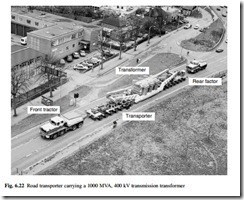Commissioning, maintenance and repair
Commissioning
Small power transformers can be transported to site complete with oil, bushings, tapchangers and cooling equipment. It is then a relatively simple matter to lift them onto a pole or plinth and connect them into the system.
Large transformers are subject to weight restrictions and size limitations. When they are moved by road or rail and it is necessary to remove the oil, bushings, cooling equipment and other accessories to meet these limitations. Very large transformers are usually carried on custom-built transporters, such as the 112-wheel transporter shown in Fig. 6.22; this road transporter is carrying a 1000 MVA, 400 kV transmission trans- former that has been dismantled to meet a 400 tonne road weight restriction. Once a transformer of this size arrives on site, it must be lifted or jacked onto its plinth for re-erection. In some cases with restricted space it may be necessary to use special techniques, such as water skates to manoeuvre the transformer into position.
When the transformer has been erected and the oil filled and reprocessed, it is necessary to carry out commissioning tests to check that all electrical connections have been correctly made and that no deterioration has occurred in the insulation system. These commissioning tests are selected from the routine tests and usually include
winding resistance and ratio, magnetizing current at 440 V, and analysis of oil samples to establish breakdown strength, water content and total gas content. If oil samples indicate high water content then it may be necessary to dry the oil using methods addressed in the following section.
Maintenance
Transformers require little maintenance in service, apart from regular inspection and servicing of the OLTC mechanism. The diverter contacts experience significant wear due to arcing, and they must be replaced at regular intervals which are determined by the operating regime. For furnace transformers it may be advisable to filter the oil regularly in a diverter compartment in order to remove carbon particles and maintain the electrical strength.
The usual method of protecting the oil breather system in small transformers is to use silicone gel breathers to dry incoming air; in larger transformers refrigerated breathers continuously dry the air in a conservator. Regular maintenance (at least once a month) is necessary to maintain a silica gel breather in efficient working order.
If oil samples indicate high water content then it may be necessary to dry the oil using a heating–vacuum process. This also indicates high water content in the paper insulation and it may be necessary to redry the windings by applying a heating and vacuum cycle on site, or to return the transformer to the manufacturer for reprocessing or refurbishment. An alternative procedure is to pass the oil continuously through a molecular sieve filter. Molecular sieves absorb up to 40 per cent of their weight of water.
Diagnostics and repair
In the event of a failure, the user must first decide whether to repair or replace the transformer. Where small transformers are involved, it is usually more economic to replace the unit. In order to reach a decision, it is usually necessary to carry out diagnostic tests to identify the number of faults and their location. Diagnostic tests may include the surveillance tests referred to in section 6.5.2, and it may also be decided to use acoustic location devices to identify a sparking site, low-voltage impulse tests to identify a winding fault and frequency response analysis of a winding to an applied square wave to detect winding conductor displacement.
If the fault is in a winding, it usually requires either replacement of the winding in a repair workshop or rewinding by the manufacturer, but many faults external to the windings, such as connection or core faults can be corrected on site.
Where a repair can be undertaken on site it is essential to maintain dry conditions in the transformer by continual purging using dry air. Any material taken into the tank must be fully processed and a careful log should be maintained of all materials taken into and brought out of the tank.
When a repair is completed, the transformer must be re-dried and re-impregnated, and the necessary tests carried out to verify that the transformer can be returned to service in good condition.
